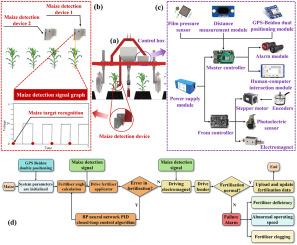Research on intelligent maize targeted fertilisation method based on BPNN PID adaptive position feedback regulation
IF 5.3
1区 农林科学
Q1 AGRICULTURAL ENGINEERING
引用次数: 0
Abstract
Given problems, such as low accuracy of fertiliser application control, large positioning errors, and poor fault monitoring effects in targeted fertilisation operations, this study proposes an intelligent maize-targeted fertilisation method based on a Backpropagation Neural Network (BPNN) Proportional-Integral-Derivative (PID) adaptive position feedback regulation. With the STM32 microcontroller as the master-slave controller, an intelligent maize-targeted fertilisation system was developed through the design of multi-sensor fusion, control parameter calculation and optimisation, construction of a fertilisation drive device, and fault monitoring system. BPNN PID adaptive optimisation was used to control the angular displacement of the fertiliser applicator, and automatic control technology drove the targeted fertilisation mechanism. By integrating dual photoelectric sensors to detect the target maize, an encoder collects the angular displacement of the fertiliser applicator, a ranging sensor monitors the fertiliser amount in the fertiliser box, a pressure sensor monitors the status of the fertiliser pipe, a positioning sensor monitors the operation speed, and multi-machine communication processes the fertilisation operation data. Targeted control and fault monitoring of fertilisation operations under multi-sensor fusion were realised. The adjustment time of the optimisation algorithm is 0.9 s, and the response is fast. Experiments show that the accuracy of fertiliser application control is greater than 95 %, the average positioning error of fertilisation is less than 28.1 mm, the fault alarm success rate reaches 97 %, and the average response time of fault alarm is less than 0.45 s. The intelligent maize-targeted fertilisation method in this study can achieve precise fertilisation control in maize-targeted fertilisation operations.

基于bp神经网络PID自适应位置反馈调节的智能玉米定向施肥方法研究
针对定向施肥操作中存在的施肥控制精度低、定位误差大、故障监测效果差等问题,提出了一种基于反向传播神经网络(BPNN)比例-积分-导数(PID)自适应位置反馈调节的玉米定向施肥智能方法。以STM32单片机为主从控制器,通过多传感器融合设计、控制参数计算与优化、施肥驱动装置搭建、故障监测系统等,研制了玉米定向智能施肥系统。采用bp神经网络PID自适应优化控制施肥器的角位移,自动控制技术驱动目标施肥机构。通过集成双光电传感器对目标玉米进行检测,编码器采集施肥器的角位移,测距传感器监测施肥箱内的施肥量,压力传感器监测施肥管状态,定位传感器监测施肥速度,多机通信处理施肥操作数据。实现了多传感器融合下施肥作业的针对性控制和故障监测。优化算法的调整时间为0.9 s,响应速度快。实验表明,该系统施肥控制精度大于95%,施肥平均定位误差小于28.1 mm,故障报警成功率达97%,故障报警平均响应时间小于0.45 s。本研究提出的智能玉米定向施肥方法可以在玉米定向施肥操作中实现精准的施肥控制。
本文章由计算机程序翻译,如有差异,请以英文原文为准。
求助全文
约1分钟内获得全文
求助全文
来源期刊

Biosystems Engineering
农林科学-农业工程
CiteScore
10.60
自引率
7.80%
发文量
239
审稿时长
53 days
期刊介绍:
Biosystems Engineering publishes research in engineering and the physical sciences that represent advances in understanding or modelling of the performance of biological systems for sustainable developments in land use and the environment, agriculture and amenity, bioproduction processes and the food chain. The subject matter of the journal reflects the wide range and interdisciplinary nature of research in engineering for biological systems.
 求助内容:
求助内容: 应助结果提醒方式:
应助结果提醒方式:


